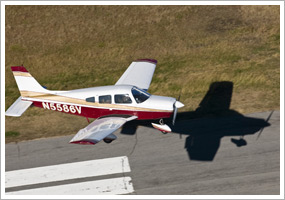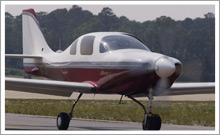|
|
| ||||
| | FT News | INSIDE AOPA | TRAINING PRODUCTS | FINAL EXAM | |||
TRAINING TIPs Cross-controlled “The pilot coordinates rudder pressure with aileron inputs to eliminate the effects of aileron drag (adverse yaw) during turns. And coordination during slow flight ensures that an inadvertent stall will not become a spin,” explained the Oct. 11, 2002, “Training Tip: Coordinated flight.” The lessons are clearly learned when the pilot can feel the slipping or skidding of uncoordinated flight—no longer dependent on instrument indications to sense its presence—and makes instinctive corrections. For every rule there is an exception, and there are situations where intentionally uncoordinated flight—that is, flight with crossed controls—is needed. After all the necessary emphasis on coordination, learning to break the rule when appropriate can be a challenge. That learning hurdle is best overcome with lots of practice, resulting in lots of confidence. Slipping maneuvers are a case in point. Putting the trainer into an aggressive forward slip to lose altitude on a power-off or practice emergency landing is short on smoothness and coordination, but long on results. “When performing the forward slip to lose altitude on final approach, the pilot lowers a wing with aileron and feeds in opposite rudder to prevent the aircraft from turning away from the approach course. The airplane's longitudinal axis is now positioned at an angle to its flight path, which increases drag and creates a higher descent rate on the approach,” explained the Feb. 24, 2006, “Training Tip: Forward slips, sideslips.” “‘Sideslipping’ to handle a crosswind on final approach also requires holding a wing low and opposite rudder—but there is an important difference. The aircraft's longitudinal axis is kept aligned with the extended runway centerline.” There are other situations, as when touching down in rough, gusty air, when you must do what’s necessary with the flight controls to maintain runway alignment (rudder) and avoid drift (aileron), even if the momentary result is flying cross-controlled. Most of the time, smooth, coordinated control inputs exemplify correct technique and showcase your knowledge. Demonstrating how to break the rule correctly is another step along the road to your pilot certificate. YOUR PARTNER IN TRAININGWell, you did it. You made up your mind to learn to fly this summer. What kind of flight school is right for you—big, small, or something in between? Get some practical advice and insight by reading “Choosing the right school.” Flight Training Online has everything you need to know to get started.
Did you know that student pilots who join AOPA are three times more likely to complete their flight training? Membership includes unlimited access to aviation information by phone (800/USA-AOPA, weekdays from 8:30 a.m. to 6 p.m. Eastern time) or from Flight Training Online or AOPA Online. If you're not already a member, join today and get the pilot’s edge. Login information is available online. FLIGHT TRAINING NEWSPurdue/Able Flight program adds LSAStudents in the Able Flight training program at Purdue University now have two aircraft at their disposal: the tandem-seat Sky Arrow 600, which was used in 2010 during the program’s inaugural session, and a side-by-side-seat Flight Design CTLS. Able Flight grants full scholarships for individuals with physical disabilities who are 17 years or older to earn their sport pilot certificate. Read more >> Skycatcher lands in Sporty’s training fleetSporty’s Academy at Clermont County Airport in Batavia, Ohio, has added a 2011 Cessna 162 Skycatcher to its rental fleet. The Skycatcher is available for sport, recreational, and private pilot training, as well as glass cockpit transition training. It can be rented for an introductory rate of $99 per hour. For more information, see the website. Approach charts: Are you up for a challenge?Some instrument approaches are pretty simple: a scan of the layout, a review of the numbers, and you’re off to the races. Sometimes, though, things are more complicated, and you need to look very closely or risk missing critical information. The Air Safety Institute’s latest safety quiz, sponsored by the AOPA Insurance Agency, looks at one of the latter situations—a localizer back course with a couple of tricks up its sleeve. Are you up for a challenge? Take the quiz. Then, delve deeper into the topic with the online course IFR Chart Challenge: VOR Approach , and see if your choices are correct and safe. The course qualifies for AOPA Accident Forgiveness. Husband and wife open Mich. flight schoolDan and Johanna Walker have opened a new flight school that features sport pilot instruction at Lenawee County Airport in Adrian, Mich. Skywalker Flying had its grand opening on June 28. The Walkers decided to start the business when the airport lost its previous flight school, which relocated to Ohio, according to The Daily Telegram. For more information, see the website. Arizona Cardinals assistant coach solosRay Horton, a defensive coordinator for the Arizona Cardinals, is using down time while the National Football League is on work stoppage to learn to fly. Horton soloed in June at Chandler Municipal Airport in Arizona, according to USA Today. He began training in May and hopes to take his checkride by the end of July. France announces private pilot instrument ratingFrench private pilots now have the option to earn an instrument rating similar to that in the United States. Rather than go through the expense of training for the rating under pan-European rules, they can earn a rating that suits the needs and operations of private pilots. Read more >> Inside AOPAAOPA T-shirts perfect for summerBusiness casual, semi-formal, resort casual—forget about it! It’s summer, and that means shorts and T-shirts. Outfit yourself and your family to show off your passion for aviation with an all-new AOPA T-shirt. This T-shirt comes in gray or olive and shows not only the AOPA logo, but also that the association was established in 1939. The shirt makes a great conversation starter around the grill or on the beach. Read more >> The lunch crunchLet’s face it: The morning cup of coffee only gets us so far in the day. By lunchtime, our bodies need some good, healthy input to help us remain productive. Lunchtime is the perfect time to refuel both physically and mentally. AOPA staffer and certified personal trainer Marci D’Alessio provides some “do’s” and “don’ts” to keep in mind so that you can make this time work for you. Read more in this selection from the Medical Services Program newsletter. TRAINING PRODUCTSVFRMap.com adds airport/facility directory searchThe creators of VFRMap.com, a free online source of VFR and IFR charts, have added an airport/facility directory search function. Still in beta, the feature is optimized for mobile browsers. While it will eventually be a part of VFRMap.com, you can check it out here.
Note: Products listed have not been evaluated by ePilot editors unless otherwise noted. AOPA assumes no responsibility for products or services listed or for claims or actions by manufacturers or vendors. FINAL EXAMQuestion: I rent an airplane from my local FBO for my private pilot flight training. Is it necessary for me to have renters insurance?
Answer: While your FBO may not require it, having your own insurance coverage is strongly recommended. Here’s why: An FBO’s insurance policy is designed to protect the FBO, not the renter. You can be held liable for injuries to passengers, damage to property, and even damage to the aircraft itself. Also, if you damage the aircraft and the FBO turns in a claim for damage beyond its deductible to its insurance company, the insurance company can pay the FBO for the damage, and then take action against you to collect the amount it paid to the FBO. This is called “subrogation.” You also could be liable for the FBO’s deductible, which could potentially cost you thousands of dollars. With renters insurance available for less than the cost of a few hours of flight time, it only makes sense to get covered. The AOPA Insurance Agency provides renters insurance. For more information, read “When you rent an airplane, what coverage do you need?”
Got a question for our technical services staff? Email [email protected] or call the Pilot Information Center, 800/872-2672. Don’t forget the online archive of “Final Exam” questions and answers, searchable by keyword or topic. What’s New OnlineWhat task can you perform with your students that also will bolster your CFI resume? Find out in this week’s Flight Training blog. AOPA Career OpportunitiesEver dream of turning your passion for aviation into a career? We’re looking for an application support engineer, Dot Net developer, and electronic advertising manager. To learn more about other AOPA career opportunities, visit AOPA Online. Picture Perfect AVIATION EVENTS & WEATHER To include an event or to search all events in the calendar, visit AOPA Online. For airport details, including FBO fuel prices, see AOPA Airports. Flight Instructor Refresher ClinicsThe next Air Safety Institute Flight Instructor Refresher Clinics are scheduled in Memphis, Tenn., July 9 and 10; Jacksonville, Fla., July 16 and 17; Newark, N.J., and Pittsburgh, Pa., July 23 and 24; and Atlanta, Ga., and Fort Worth, Texas, August 6 and 7. For a complete schedule, see AOPA Online.
Can’t make it in person? Sign up for the CFI Refresher Online. Air Safety Institute Safety SeminarsAir Safety Institute Safety Seminars are scheduled in Oshkosh, Wis., July 27 through 29; and Germantown, Tenn., Wichita, Kan., Fort Worth, Texas, and West Houston, Texas, Sept. 12. | Advertisers Got news? Contact ePilot. Having difficulty using this service? Visit the ePilot Frequently Asked Questions now at AOPA Online or write to [email protected]. |
| Member Tools : Send feedback | ePilot Archive Editorial Team: ePilot Flight Training Editor : Jill W. Tallman | ePilot Editor: Sarah Brown | Contributor: Alton K. Marsh |

 Student pilots hear a lot about coordinated flight at the outset of training. It can’t be emphasized too much to the beginning student pilot that the flight controls, when applied in harmony, produce smooth maneuvers that guarantee safety and meet
Student pilots hear a lot about coordinated flight at the outset of training. It can’t be emphasized too much to the beginning student pilot that the flight controls, when applied in harmony, produce smooth maneuvers that guarantee safety and meet 


